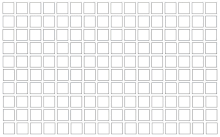
A push broom scanner, also known as an along-track scanner, is a device for obtaining images with spectroscopic sensors. The scanners are regularly used for passive remote sensing from space, and in spectral analysis on production lines, for example with near-infrared spectroscopy used to identify contaminated food and feed. The moving scanner line in a traditional photocopier (or a scanner or facsimile machine) is also a familiar, everyday example of a push broom scanner. Push broom scanners and the whisk broom scanners variant (also known as across-track scanners) are often contrasted with staring arrays (such as in a digital camera), which image objects without scanning, and are more familiar to most people.
In orbital push broom sensors, a line of sensors arranged perpendicular to the flight direction of the spacecraft is used. Different areas of the surface are imaged as the spacecraft flies forward. A push broom scanner can gather more light than a whisk broom scanner because it looks at a particular area for a longer time, like a long exposure on a camera. One drawback of push broom sensors is the varying sensitivity of the individual detectors. Another drawback is that the resolution is lower than a whisk broom scanner because the entire image is captured at once.
Examples of spacecraft cameras using push broom imagers include Mars Express's High Resolution Stereo Camera, Lunar Reconnaissance Orbiter Camera NAC, Mars Global Surveyor's Mars Orbiter Camera WAC, and the Multi-angle Imaging SpectroRadiometer on board the Terra satellite.
See also
References
- Vincent Baeten; Philippe Vermeulen; Juan Antonio Fernández Pierna & Pierre Dardenne (June 2014). "From targeted to untargeted detection of contaminants and foreign bodies in food and feed using NIR spectroscopy". New Food magazine. pp. 18–23. Retrieved 26 June 2014.
- ^ Hoekzema, Nick. "Planetary & Cometary Exploration Cameras on Orbiters and Landers". Archived from the original on 2014-02-19. Retrieved 2 February 2014.
- Neal-Jones, Nancy (2014-01-29). "NASA's LRO Snaps a Picture of NASA's LADEE Spacecraft". NASA. Retrieved 2 February 2014.
- K. N. Burns; E. J. Speyerer; M. S. Robinson; T. Tran; M. R. Rosiek; B. A. Archinal; E. Howington-Kraus; LROC Science Team (25 August 2012). "Digital Elevation Models and Derived Products from LROC NAC STEREO observations" (PDF). International Archives of the Photogrammetry, Remote Sensing and Spatial Information Sciences, Volume XXXIX-B4, 2012 XXII ISPRS Congress. p. 483. Retrieved 2 February 2014.
External links
- Earth Observing-1 (NASA), with animated whisk broom and push broom illustrations
- Airborne Pushbroom Line Scan (PDF) – overview article
- Linear Pushbroom Cameras (PDF) – detailed modelling theory
This technology-related article is a stub. You can help Misplaced Pages by expanding it. |